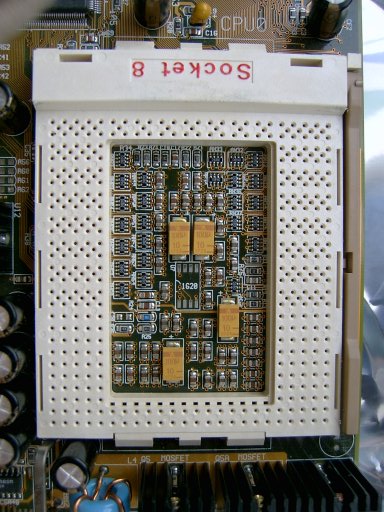Here is the socket in question:

I have consulted google to help clarify the confusion about this mysterious Socket 8 and it's cpus known as Pentium Pros.
Here are the results that google has for 'INTEL Socket 8'
http://www.google.com/search?source...=GGLJ,GGLJ:2006-40,GGLJ:en&q="Intel+socket+8"
Produced 13,200 results when I checked it.
Here are googles results for 'AMD Socket 8'
http://www.google.com/search?source...ls=GGLJ,GGLJ:2006-40,GGLJ:en&q="AMD+socket+8"
Produced 2 results when I checked it.
The first has no reference to "Socket 8". I have no idea why google pulled it.
The second has a error in the description of the motherboard socket as a socket 8 which is in fact supposed to be Socket 939 according to the mobo's manufacturers link on the same page:
http://www.gigabyte.com.tw/Products...px?ProductID=2214&ProductName=GA-K8N51PVM9-RH
Here's wiki's info on the Pentium Pro cpus:
http://en.wikipedia.org/wiki/Pentium_pro
Please note the bus speed of a Pentium Pro is 60-66 MHz under 'Available models' none were ever sold with a 100 MHz FSB (front side bus).
Look at the 'Pentium Pro / 6th generation competitors' sections where it references the competitors technology at the time especially the AMD K5 (socket 5 and 7 varieties) and K6 (socket 7).
When you are done with these references you should be certain that ALL Pentium Pro cpus you buy on ebay or any where in the world WILL be stamped INTEL and will fit into a socket 8 motherboard. So if you have processed any 'Pentium Pro' cpus they have been exclusively Intel cpus.
If AMD ever manuafactured a Socket 8 cpu it was for lab use only. I doubt very seriously this ever happened.
Steve
P.S. I am not a PCI card. Post any new topic to the forum and PM me the link then I'll send you the next clue. :wink:

I have consulted google to help clarify the confusion about this mysterious Socket 8 and it's cpus known as Pentium Pros.
Here are the results that google has for 'INTEL Socket 8'
http://www.google.com/search?source...=GGLJ,GGLJ:2006-40,GGLJ:en&q="Intel+socket+8"
Produced 13,200 results when I checked it.
Here are googles results for 'AMD Socket 8'
http://www.google.com/search?source...ls=GGLJ,GGLJ:2006-40,GGLJ:en&q="AMD+socket+8"
Produced 2 results when I checked it.
The first has no reference to "Socket 8". I have no idea why google pulled it.
The second has a error in the description of the motherboard socket as a socket 8 which is in fact supposed to be Socket 939 according to the mobo's manufacturers link on the same page:
http://www.gigabyte.com.tw/Products...px?ProductID=2214&ProductName=GA-K8N51PVM9-RH
Here's wiki's info on the Pentium Pro cpus:
http://en.wikipedia.org/wiki/Pentium_pro
Please note the bus speed of a Pentium Pro is 60-66 MHz under 'Available models' none were ever sold with a 100 MHz FSB (front side bus).
Look at the 'Pentium Pro / 6th generation competitors' sections where it references the competitors technology at the time especially the AMD K5 (socket 5 and 7 varieties) and K6 (socket 7).
When you are done with these references you should be certain that ALL Pentium Pro cpus you buy on ebay or any where in the world WILL be stamped INTEL and will fit into a socket 8 motherboard. So if you have processed any 'Pentium Pro' cpus they have been exclusively Intel cpus.
If AMD ever manuafactured a Socket 8 cpu it was for lab use only. I doubt very seriously this ever happened.
Steve
P.S. I am not a PCI card. Post any new topic to the forum and PM me the link then I'll send you the next clue. :wink:




